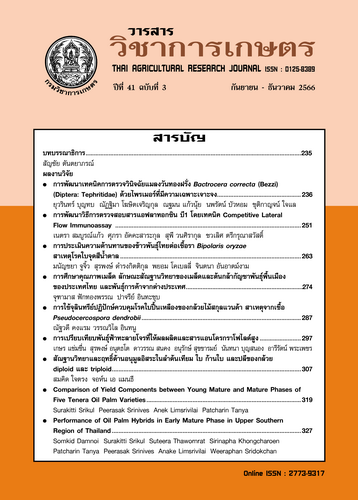การใช้จุลินทรีย์ปฏิปักษ์ควบคุมโรคใบปื้นเหลืองของกล้วยไม้สกุลแวนด้า สาเหตุจากเชื้อ Pseudocercospora dendrobii
DOI:
https://doi.org/10.14456/thaidoa-agres.2023.24คำสำคัญ:
โรคใบปื้นเหลือง, Bacillus amyloliquefaciens, Bacillus cereus, Trichoderma asperellum สายพันธุ์ CB-Pin-01, การควบคุมโดยชีววิธีบทคัดย่อ
การทดลองนี้มีวัตถุประสงค์เพื่อศึกษา ประสิทธิภาพของจุลินทรีย์ปฏิปักษ์จำนวน 3 ชนิด ในการยับยั้งการเจริญของเชื้อรา Pseudocercospora dendrobii เพื่อควบคุมโรคใบปื้นเหลืองของกล้วยไม้ ในสภาพแปลงเกษตรกรโดยทดสอบประสิทธิภาพของ เซลล์แขวนลอย และสารกรองของเชื้อแบคทีเรีย ปฏิปักษ์ Bacillus amyloliquefaciens, B. cereus และสปอร์แขวนลอยของเชื้อราปฏิปักษ์ Trichoderma asperellum สายพันธุ์ CB-Pin-01 ในการยับยั้ง การงอกของสปอร์เชื้อรา P. dendrobii สาเหตุ โรคใบปื้นเหลืองของกล้วยไม้สกุลแวนด้าในห้อง ปฏิบัติการ จากนั้น จึงทดสอบความสามารถของ จุลินทรีย์ปฏิปักษ์ในการควบคุมโรคใบปื้นเหลือง ในสภาพแปลง ผลการทดสอบในห้องปฏิบัติการ หลังการทดสอบที่24 ชม. พบว่า จุลินทรีย์ปฏิปักษ์ สามารถยับยั้งการงอกของสปอร์เชื้อรา P. dendrobii ได้ 85.38 - 99.74% ทำให้การเจริญของ germ tube สั้นผิดไปจากปกติเมื่อเปรียบเทียบ กับกรรมวิธีควบคุม โดยสปอร์แขวนลอยของเชื้อ T. asperellum สายพันธุ์ CB-Pin-01 และ เซลล์ แขวนลอยของเชื้อแบคทีเรีย B. amyloliquefaciens มีประสิทธิภาพในการยับยั้งการงอก germ tube ได้ดีที่สุด 99.74 และ 99.30% ตามลำดับ รองลงมาคือสารกรองของเชื้อแบคทีเรีย B. cereus เชื้อรา T. asperellum สายพันธุ์ CB-Pin-01 เชื้อแบคทีเรีย B. amyloliquefaciens และเซลล์ แขวนลอยของเชื้อแบคทีเรีย B. cereus โดยมี เปอร์เซ็นต์การยับยั้งการงอก95.13,89.83,86.61 และ 85.38% ตามลำดับ ส่วนผลการทดสอบใน สภาพแปลงพบว่า การพ่นเชื้อจุลินทรีย์ปฏิปักษ์ทั้ง 3 ชนิดบนใบกล้วยไม้ที่เป็นโรคแล้วในช่วงฤดูฝน สามารถลดการเกิดโรคได้ในช่วงเวลา 7 วัน หลังการพ่นเชื้อจุลินทรีย์ปฏิปักษ์ได้อย่างมีนัย สำคัญเมื่อเปรียบเทียบกับกรรมวิธีควบคุม โดย เชื้อแบคทีเรีย B. cereus ทำให้ขนาดของแผล ขยายน้อยที่สุดเพียง 0.01 มม. รองลงมาคือ B. amyloliquefaciens ที่มีแผลขยายขนาด 1.34 มม. ในขณะที่ขนาดของแผลในกรรมวิธี ควบคุมขยายเพิ่มขึ้น 8 มม. ส่วนการใช้สารเคมี folpet และเชื้อรา T. asperellum สายพันธุ์ CB-Pin-01 พบว่า แผลขยายขนาดเพิ่มขึ้น 5.34 และ 3.34 มม. ตามลำดับ
เอกสารอ้างอิง
กรพินธุ์ ทนกล้า. 2551. การใช้จุลินทรีย์ปฏิปักษ์ในการควบคุมโรคใบปื้นเหลืองของกล้วยไม้สกุลหวายสาเหตุจากเชื้อรา Pseudocercospora dendrobii. วิทยานิพนธ์วิทยาศาสตรมหาบัณฑิต.มหาวิทยาลัยเกษตรศาสตร์,กรุงเทพฯ. 138 หน้า.
กรมวิชาการเกษตร. 2543. มาตรฐานกล้วยไม้ของประเทศไทยและการผลิตกล้วยไม้อย่างถูกต้องและเหมาะสม. กรมวิชาการเกษตร, กระทรวงเกษตรและสหกรณ์. กรุงเทพฯ. 26 หน้า.
พราวมาส เจริญรักษ์. 2550. การใช้แบคทีเรียปฏิปักษ์ในการควบคุมโรคราใบดำของมะเขือเทศที่เกิดจากเชื้อรา Pseudocercospora fuligena [Roldan] Deighton. วิทยานิพนธ์วิทยาศาสตรมหาบัณฑิต. มหาวิทยาลัยเกษตรศาสตร์, กรุงเทพฯ. 123 หน้า.
สมศักดิ์ รักไพบูลย์สมบัติ. 2540. ปลูกเลี้ยงกล้วยไม้จากประสบการณ์. บริษัท ธรรมสาร จากัด, กรุงเทพฯ. 384 หน้า.
สำนักงานเศรษฐกิจการเกษตร. 2565. กล้วยไม้. แหล่งข้อมูล: https://mis-app.oae.go.th/product/ สืบค้น: 20 เมษายน 2566.
Briere, S.C., G.D. Francand E.D. Derr. 2001. Fungicide sensitivity characteristics of Cercospora beticola isolates recoverd from the high plains of Colorado, Montana, Nebraska and Wyoming: 1. Benzimidazole and triphenyltin hydroxide. Sugar Beet Res. 38: 111-120.
Crous, P.W., U. Braun, G.C. Hunter, M.J. Wingfield, G.J.Verkley, H.D. Shin, C. Nakashima and J. Z. Groenewald. 2013. Phylogenetic lineages in Pseudocercospora. Studies in Mycology. 75(1): 37-114.
Cruz-Martín, M., E. Mena, M. Acosta-Suárez, T. Pichardo, E. Rodriguez and Y. Alvarado-Capó.2020. Proteincompoundsof Bacillus subtilis withinvitroantifungalactivityagainst Pseudocercospora fijiensis (Morelet). Braz. J. Microbiol. 51: 265-269.
Deighton, F.C. 1983. Studies on Cercospora and allied genera. VIII. Further notes on Cercoseptoria and some new species and redispositions. Mycol. 151: 1-13.
El-Gholl, N. E., S.A. Alfieri, W.H. Ridings and C.L. Schoulties. 1982. Growth and sporulationin vitro of Cercospora apii, Cercospora arachodicola, Cercospora kikuchii and other species of Cercospora. Canad. J. Bot. 60: 862-868.
Frevel, D.R. and H.W. Spurr. 1977. Biocontrol of tobacco brown spot disease by Bacillus cereus subsp. mycoides in a controlled environment. Phytopathology. 67: 930-932.
Gesnara, W. 1994. Study on Trichoderma harzianum as a potential biocontrol agent of tomato and barley disease caused by Sclerotium rolfsii emphasis on fermentation biomass. Ph.D. Dissertation, Kasetsart University, Thailand. 110 p.
R CoreTeam.2014. R: A language and environment for statistical computing. R Foundation for Statistical Computing. Vienna, Austria. Available at: https://www.R-project.org/. Accessed: June 7, 2023.
Sontirat, P., P. Phitakpraiwan, W. Choobanroong and P. Giatgong. 1980. Plant pathogenic Cercospora in Thailand. Plant Pathology and Microbiology Division, Dept.of Agriculture. 51 p.
Thangavelu, R. and M. Mustaffa. 2010. A potential isolate of Trichoderma viride NRCB1 and its mass production for the effective management of Fusarium wilt disease in banana. Tree F. S. B. 4(2): 76-84
ดาวน์โหลด
เผยแพร่แล้ว
รูปแบบการอ้างอิง
ฉบับ
ประเภทบทความ
สัญญาอนุญาต
ลิขสิทธิ์ (c) 2023 วารสารวิชาการเกษตร

อนุญาตภายใต้เงื่อนไข Creative Commons Attribution-NonCommercial-NoDerivatives 4.0 International License.
วารสารวิชาการเกษตร



